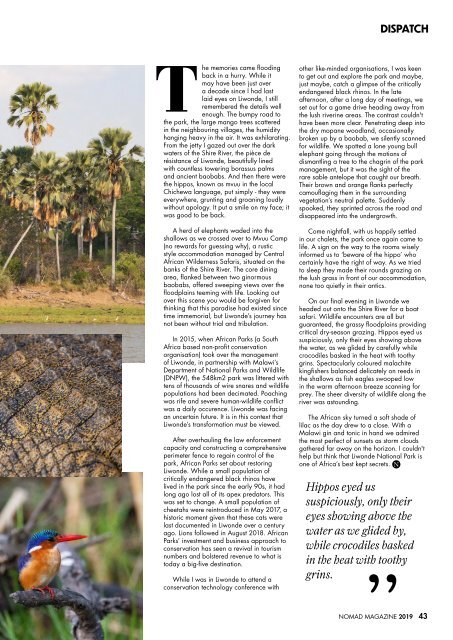You also want an ePaper? Increase the reach of your titles
YUMPU automatically turns print PDFs into web optimized ePapers that Google loves.
DISPATCH<br />
T<br />
he memories came flooding<br />
back in a hurry. While it<br />
may have been just over<br />
a decade since I had last<br />
laid eyes on Liwonde, I still<br />
remembered the details well<br />
enough. The bumpy road to<br />
the park, the large mango trees scattered<br />
in the neighbouring villages, the humidity<br />
hanging heavy in the air. It was exhilarating.<br />
From the jetty I gazed out over the dark<br />
waters of the Shire River, the pièce de<br />
résistance of Liwonde, beautifully lined<br />
with countless towering borassus palms<br />
and ancient baobabs. And then there were<br />
the hippos, known as mvuu in the local<br />
Chichewa language, put simply - they were<br />
everywhere, grunting and groaning loudly<br />
without apology. It put a smile on my face; it<br />
was good to be back.<br />
A herd of elephants waded into the<br />
shallows as we crossed over to Mvuu Camp<br />
(no rewards for guessing why), a rustic<br />
style accommodation managed by Central<br />
African Wilderness Safaris, situated on the<br />
banks of the Shire River. The core dining<br />
area, flanked between two ginormous<br />
baobabs, offered sweeping views over the<br />
floodplains teeming with life. Looking out<br />
over this scene you would be forgiven for<br />
thinking that this paradise had existed since<br />
time immemorial, but Liwonde’s journey has<br />
not been without trial and tribulation.<br />
In 2015, when African Parks (a South<br />
Africa based non-profit conservation<br />
organisation) took over the management<br />
of Liwonde, in partnership with Malawi’s<br />
Department of National Parks and Wildlife<br />
(DNPW), the 548km2 park was littered with<br />
tens of thousands of wire snares and wildlife<br />
populations had been decimated. Poaching<br />
was rife and severe human-wildlife conflict<br />
was a daily occurence. Liwonde was facing<br />
an uncertain future. It is in this context that<br />
Liwonde’s transformation must be viewed.<br />
After overhauling the law enforcement<br />
capacity and constructing a comprehensive<br />
perimeter fence to regain control of the<br />
park, African Parks set about restoring<br />
Liwonde. While a small population of<br />
critically endangered black rhinos have<br />
lived in the park since the early 90s, it had<br />
long ago lost all of its apex predators. This<br />
was set to change. A small population of<br />
cheetahs were reintroduced in May 2017, a<br />
historic moment given that these cats were<br />
last documented in Liwonde over a century<br />
ago. Lions followed in August 2018. African<br />
Parks’ investment and business approach to<br />
conservation has seen a revival in tourism<br />
numbers and bolstered revenue to what is<br />
today a big-five destination.<br />
While I was in Liwonde to attend a<br />
conservation technology conference with<br />
other like-minded organisations, I was keen<br />
to get out and explore the park and maybe,<br />
just maybe, catch a glimpse of the critically<br />
endangered black rhinos. In the late<br />
afternoon, after a long day of meetings, we<br />
set out for a game drive heading away from<br />
the lush riverine areas. The contrast couldn't<br />
have been more clear. Penetrating deep into<br />
the dry mopane woodland, occasionally<br />
broken up by a baobab, we silently scanned<br />
for wildlife. We spotted a lone young bull<br />
elephant going through the motions of<br />
dismantling a tree to the chagrin of the park<br />
management, but it was the sight of the<br />
rare sable antelope that caught our breath.<br />
Their brown and orange flanks perfectly<br />
camouflaging them in the surrounding<br />
vegetation’s neutral palette. Suddenly<br />
spooked, they sprinted across the road and<br />
disappeared into the undergrowth.<br />
Come nightfall, with us happily settled<br />
in our chalets, the park once again came to<br />
life. A sign on the way to the rooms wisely<br />
informed us to ‘beware of the hippo’ who<br />
certainly have the right of way. As we tried<br />
to sleep they made their rounds grazing on<br />
the lush grass in front of our accommodation,<br />
none too quietly in their antics.<br />
On our final evening in Liwonde we<br />
headed out onto the Shire River for a boat<br />
safari. Wildlife encounters are all but<br />
guaranteed, the grassy floodplains providing<br />
critical dry-season grazing. Hippos eyed us<br />
suspiciously, only their eyes showing above<br />
the water, as we glided by carefully while<br />
crocodiles basked in the heat with toothy<br />
grins. Spectacularly coloured malachite<br />
kingfishers balanced delicately on reeds in<br />
the shallows as fish eagles swooped low<br />
in the warm afternoon breeze scanning for<br />
prey. The sheer diversity of wildlife along the<br />
river was astounding.<br />
The African sky turned a soft shade of<br />
lilac as the day drew to a close. With a<br />
Malawi gin and tonic in hand we admired<br />
the most perfect of sunsets as storm clouds<br />
gathered far away on the horizon. I couldn't<br />
help but think that Liwonde National Park is<br />
one of Africa’s best kept secrets.<br />
Hippos eyed us<br />
suspiciously, only their<br />
eyes showing above the<br />
water as we glided by,<br />
while crocodiles basked<br />
in the heat with toothy<br />
grins.<br />
NOMAD MAGAZINE 2019 43

















